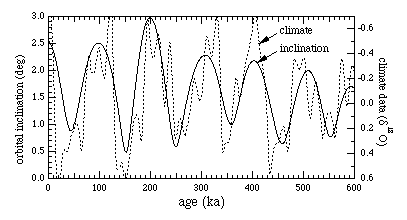
(as published in NATURE, vol. 377, p. 107-8, 14 September 1995)
Richard A. Muller
Department of Physics and Lawrence Berkeley Laboratory
University of California, Berkeley
and
Gordon J. MacDonald
Institute of Global Conflict & Cooperation
University of California, San Diego
According to the Milankovitch theory, the 100 kyr glacial cycle is caused by changes in insolation (solar heating) brought about by variations in the eccentricity of the earth's orbit. However there are serious theoretical difficulties. The insolation variations are too small to drive the cycles, and a predicted strong 400 kyr modulation is not present. Moreover, there are specific disagreements between a strong glacial cycle at both 400 ka and the present, times when the eccentricity modulation is near zero; this conflict is also called the "Stage-11 problem." (ref 1). In addition, improved measurements have uncovered an apparent causality problem: the sudden terminations of the glacial cycles appear to precede the increases in insolation, although this interpretation has been disputed. (ref 2) We suggest that a radical solution is necessary to solve these problems, and we propose that the 100 kyr glacial cycle is caused not by eccentricity but by the previously ignored parameter: the orbital inclination i, the tilt of the earth's orbital plane.
Ancient climate is recorded in sediment through change in the oxygen isotope ratio, delta(O-18), which is believed to reflect the percentage of the Earth's water frozen in ice. The figure shows delta(O-18) (dotted line) for the last 600,000 years from the SPECMAP compilation of data from five sea-floor cores.(ref 3) The figure also shows the orbital inclination i (solid line), calculated by direct integration of planetary perturbations,(ref 4) transformed to the invariable plane (the plane of symmetry of the solar system), and shifted to give the best least-squares fit to the delta(O-18) data.

Comparison of orbital inclination (solid line, lagged by 33 kyr) and delta(O-18) climate data (dotted line) from SPECMAP
Only three parameters were adjusted, one for the delay, and two for the overall scale.) For the best fit, i preceded delta(O-18) by 33 ±3 kyr; since this is positive, there is no causality problem. Likewise the presence of a strong variation in i near 400 ka solves the Stage-11 problem.
The existence of the 100 kyr cycle of orbital inclination does not seem to have been previously noticed by climatologists or astronomers. It may have been missed for two reasons. Ever since Milankovitch, the implicit assumption has been that insolation is the driving force for climate cycles, and insolation is not directly affected by orbital inclination. Secondly, the 100 kyr cycle is not evident when i is calculated in the usual reference frame based on the present orbit of the earth. Only when transformed to the invariable plane (or a plane near it) does the 100 kyr cycle unmix from the obscuring effect of a strong 70 kyr orbital precession cycle. We note that a 70 kyr cycle has been reported in delta(O-18) data from other sedimentary samples, and we suggest that this cycle may be related to orbital precession.
The only mechanism we have found that could link orbital inclination to climate is extraterrestrial accretion of meteoroids or dust. Such material can be detected in ice and sedimentary rock through analysis of iridium; Walter Alvarez has pointed out that extraterrestrial dust cycles could be detected using He-3. If this mechanism is correct, then a 100 kyr cycle should be seen in ice and sediment records of extraterrestrial accretion.
References
1. J. Imbrie et al., Paleoceanography 8, 699-735 (1993)
2. I. J. Winograd et al, Science 258, 255-260 (1992); B. J. Szabo et al., Science 266, 1994; J. Imbrie et al., Nature 363, 531-533 (1993); I. J. Winograd and J. Landwehr, USGS Open-File report 93-357, Reston VA (1993); W. S. Broecker, Nature 359, 779-780 (1992); N. Shackleton, Nature 362, 596 (1993); K. Ludwig et al., Nature 362, 596 (1993); C. Emiliani, Nature 364, 583 (1993); J. Landwehr et al., Science 368, 594 (1994).
3. J. J. Imbrie et al., in Milankovitch and Climate, Part 1, (eds. A. L. Berger et al.), pp. 269-305. D. Reidel (1984).
4. T. R. Quinn, S. Tremaine, M. Duncan, Astron. Jour. 101, 2287-2305 (1991).